Comprehensive Guide to First Aid: Obligations, Duty, and Emergency
VerifiedAdded on 2023/06/10
|12
|3617
|261
Homework Assignment
AI Summary
This assignment provides a detailed overview of first aid, covering the obligations of persons conducting a business or undertaking (PCBU) as per Work Health and Safety Regulations 2011, the duty of care of trained first aiders and healthcare professionals, and the differences between expressed and implied consent. It also identifies legal factors that determine when first aid can be provided without consent, destressing strategies following emergencies, and the importance of debriefing. The assignment further explains how to assess a collapsed person's response, anatomical and physiological changes in an unconscious person, and what happens to vital organs during CPR. It covers the recommended CPR rate, conditions for ceasing CPR, the chain of survival, visual and verbal casualty assessments, stress management techniques, and how to assess breathing. Finally, it provides specific first aid management guidelines for scenarios like thermal burns, crush injuries, hypoglycaemia, dislocations, drowning, hypothermia, heat exhaustion, and heat stroke. Desklib offers more solved assignments and study resources for students.
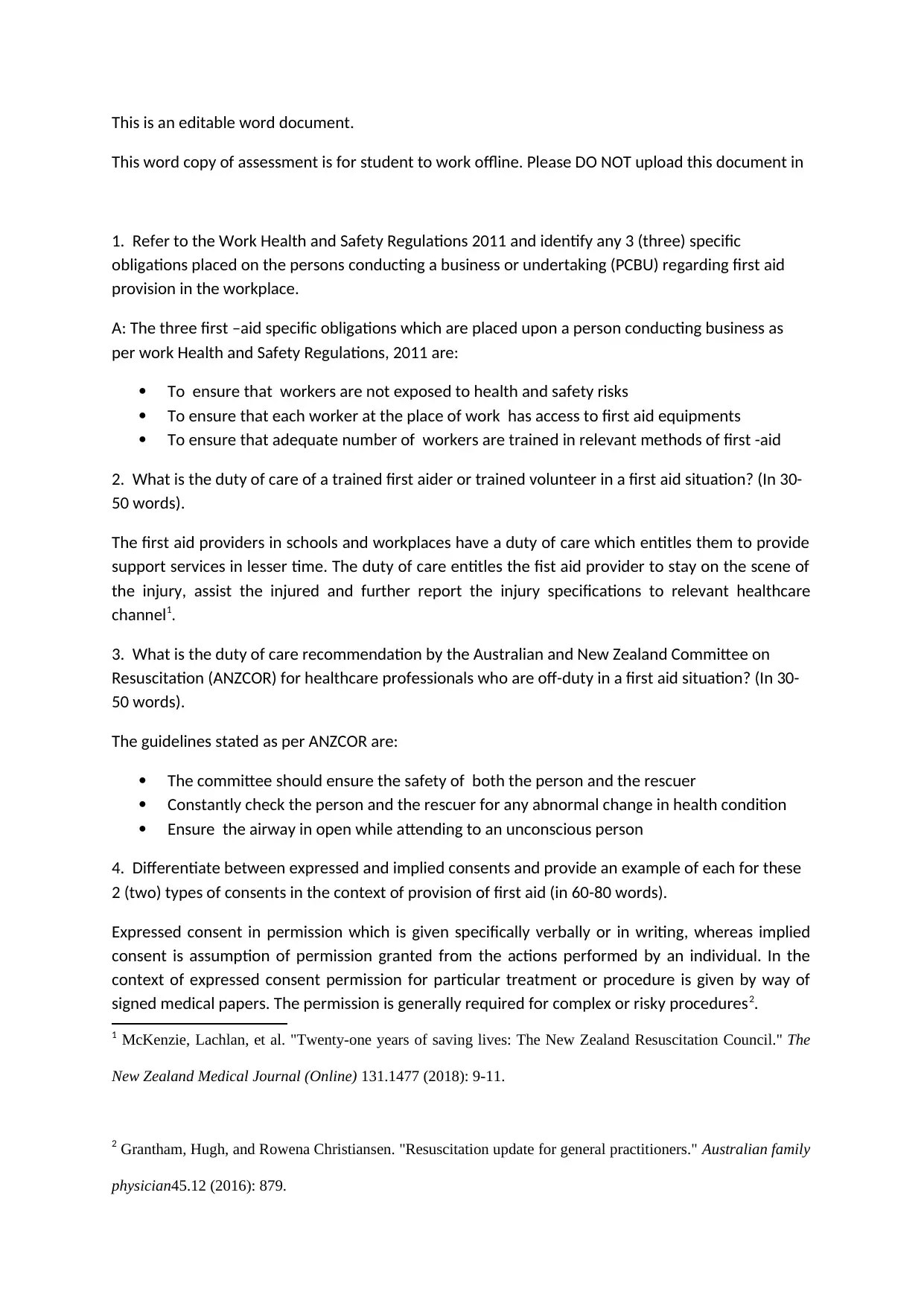
This is an editable word document.
This word copy of assessment is for student to work offline. Please DO NOT upload this document in
1. Refer to the Work Health and Safety Regulations 2011 and identify any 3 (three) specific
obligations placed on the persons conducting a business or undertaking (PCBU) regarding first aid
provision in the workplace.
A: The three first –aid specific obligations which are placed upon a person conducting business as
per work Health and Safety Regulations, 2011 are:
To ensure that workers are not exposed to health and safety risks
To ensure that each worker at the place of work has access to first aid equipments
To ensure that adequate number of workers are trained in relevant methods of first -aid
2. What is the duty of care of a trained first aider or trained volunteer in a first aid situation? (In 30-
50 words).
The first aid providers in schools and workplaces have a duty of care which entitles them to provide
support services in lesser time. The duty of care entitles the fist aid provider to stay on the scene of
the injury, assist the injured and further report the injury specifications to relevant healthcare
channel1.
3. What is the duty of care recommendation by the Australian and New Zealand Committee on
Resuscitation (ANZCOR) for healthcare professionals who are off-duty in a first aid situation? (In 30-
50 words).
The guidelines stated as per ANZCOR are:
The committee should ensure the safety of both the person and the rescuer
Constantly check the person and the rescuer for any abnormal change in health condition
Ensure the airway in open while attending to an unconscious person
4. Differentiate between expressed and implied consents and provide an example of each for these
2 (two) types of consents in the context of provision of first aid (in 60-80 words).
Expressed consent in permission which is given specifically verbally or in writing, whereas implied
consent is assumption of permission granted from the actions performed by an individual. In the
context of expressed consent permission for particular treatment or procedure is given by way of
signed medical papers. The permission is generally required for complex or risky procedures2.
1 McKenzie, Lachlan, et al. "Twenty-one years of saving lives: The New Zealand Resuscitation Council." The
New Zealand Medical Journal (Online) 131.1477 (2018): 9-11.
2 Grantham, Hugh, and Rowena Christiansen. "Resuscitation update for general practitioners." Australian family
physician45.12 (2016): 879.
This word copy of assessment is for student to work offline. Please DO NOT upload this document in
1. Refer to the Work Health and Safety Regulations 2011 and identify any 3 (three) specific
obligations placed on the persons conducting a business or undertaking (PCBU) regarding first aid
provision in the workplace.
A: The three first –aid specific obligations which are placed upon a person conducting business as
per work Health and Safety Regulations, 2011 are:
To ensure that workers are not exposed to health and safety risks
To ensure that each worker at the place of work has access to first aid equipments
To ensure that adequate number of workers are trained in relevant methods of first -aid
2. What is the duty of care of a trained first aider or trained volunteer in a first aid situation? (In 30-
50 words).
The first aid providers in schools and workplaces have a duty of care which entitles them to provide
support services in lesser time. The duty of care entitles the fist aid provider to stay on the scene of
the injury, assist the injured and further report the injury specifications to relevant healthcare
channel1.
3. What is the duty of care recommendation by the Australian and New Zealand Committee on
Resuscitation (ANZCOR) for healthcare professionals who are off-duty in a first aid situation? (In 30-
50 words).
The guidelines stated as per ANZCOR are:
The committee should ensure the safety of both the person and the rescuer
Constantly check the person and the rescuer for any abnormal change in health condition
Ensure the airway in open while attending to an unconscious person
4. Differentiate between expressed and implied consents and provide an example of each for these
2 (two) types of consents in the context of provision of first aid (in 60-80 words).
Expressed consent in permission which is given specifically verbally or in writing, whereas implied
consent is assumption of permission granted from the actions performed by an individual. In the
context of expressed consent permission for particular treatment or procedure is given by way of
signed medical papers. The permission is generally required for complex or risky procedures2.
1 McKenzie, Lachlan, et al. "Twenty-one years of saving lives: The New Zealand Resuscitation Council." The
New Zealand Medical Journal (Online) 131.1477 (2018): 9-11.
2 Grantham, Hugh, and Rowena Christiansen. "Resuscitation update for general practitioners." Australian family
physician45.12 (2016): 879.
Paraphrase This Document
Need a fresh take? Get an instant paraphrase of this document with our AI Paraphraser
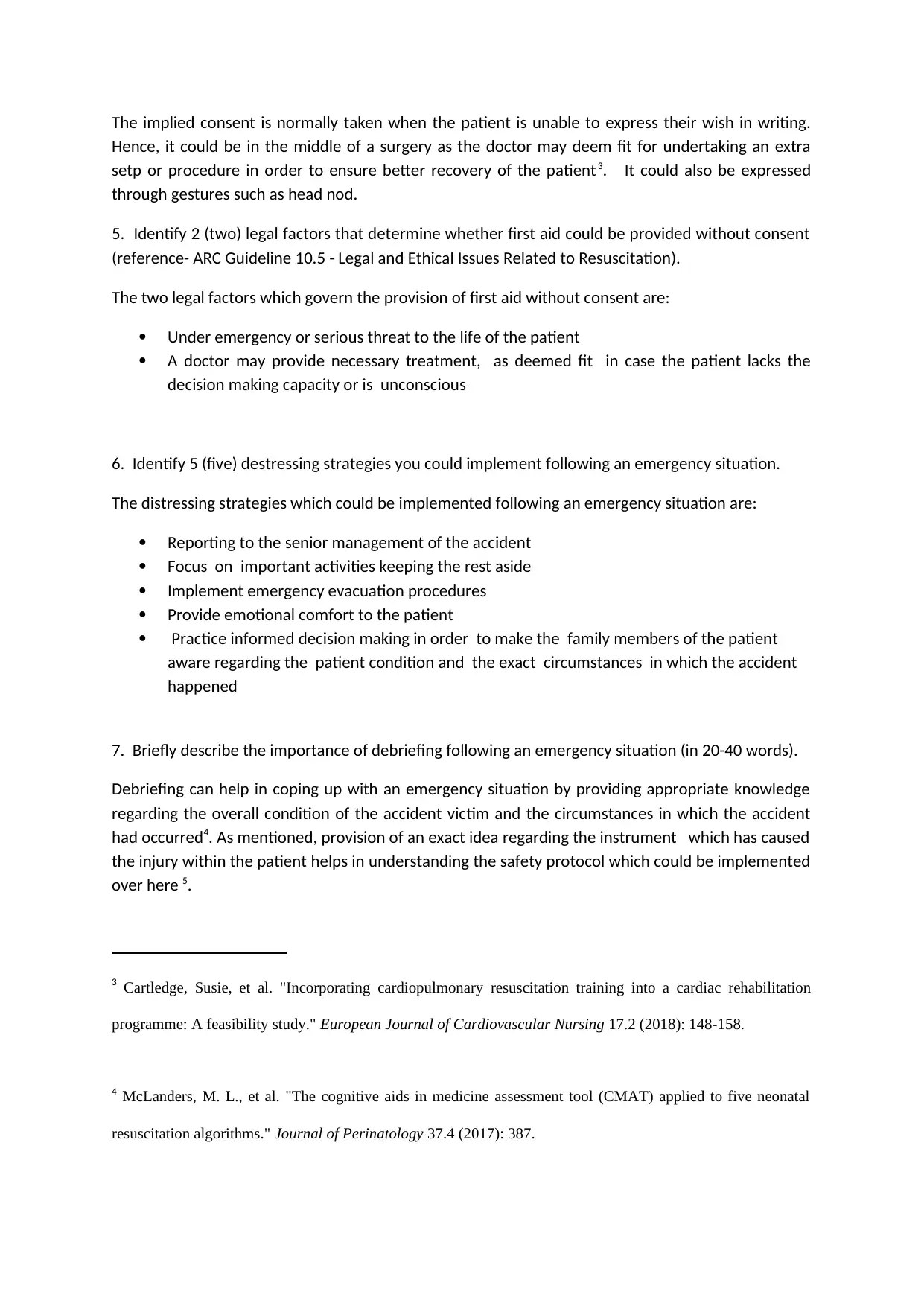
The implied consent is normally taken when the patient is unable to express their wish in writing.
Hence, it could be in the middle of a surgery as the doctor may deem fit for undertaking an extra
setp or procedure in order to ensure better recovery of the patient3. It could also be expressed
through gestures such as head nod.
5. Identify 2 (two) legal factors that determine whether first aid could be provided without consent
(reference- ARC Guideline 10.5 - Legal and Ethical Issues Related to Resuscitation).
The two legal factors which govern the provision of first aid without consent are:
Under emergency or serious threat to the life of the patient
A doctor may provide necessary treatment, as deemed fit in case the patient lacks the
decision making capacity or is unconscious
6. Identify 5 (five) destressing strategies you could implement following an emergency situation.
The distressing strategies which could be implemented following an emergency situation are:
Reporting to the senior management of the accident
Focus on important activities keeping the rest aside
Implement emergency evacuation procedures
Provide emotional comfort to the patient
Practice informed decision making in order to make the family members of the patient
aware regarding the patient condition and the exact circumstances in which the accident
happened
7. Briefly describe the importance of debriefing following an emergency situation (in 20-40 words).
Debriefing can help in coping up with an emergency situation by providing appropriate knowledge
regarding the overall condition of the accident victim and the circumstances in which the accident
had occurred4. As mentioned, provision of an exact idea regarding the instrument which has caused
the injury within the patient helps in understanding the safety protocol which could be implemented
over here 5.
3 Cartledge, Susie, et al. "Incorporating cardiopulmonary resuscitation training into a cardiac rehabilitation
programme: A feasibility study." European Journal of Cardiovascular Nursing 17.2 (2018): 148-158.
4 McLanders, M. L., et al. "The cognitive aids in medicine assessment tool (CMAT) applied to five neonatal
resuscitation algorithms." Journal of Perinatology 37.4 (2017): 387.
Hence, it could be in the middle of a surgery as the doctor may deem fit for undertaking an extra
setp or procedure in order to ensure better recovery of the patient3. It could also be expressed
through gestures such as head nod.
5. Identify 2 (two) legal factors that determine whether first aid could be provided without consent
(reference- ARC Guideline 10.5 - Legal and Ethical Issues Related to Resuscitation).
The two legal factors which govern the provision of first aid without consent are:
Under emergency or serious threat to the life of the patient
A doctor may provide necessary treatment, as deemed fit in case the patient lacks the
decision making capacity or is unconscious
6. Identify 5 (five) destressing strategies you could implement following an emergency situation.
The distressing strategies which could be implemented following an emergency situation are:
Reporting to the senior management of the accident
Focus on important activities keeping the rest aside
Implement emergency evacuation procedures
Provide emotional comfort to the patient
Practice informed decision making in order to make the family members of the patient
aware regarding the patient condition and the exact circumstances in which the accident
happened
7. Briefly describe the importance of debriefing following an emergency situation (in 20-40 words).
Debriefing can help in coping up with an emergency situation by providing appropriate knowledge
regarding the overall condition of the accident victim and the circumstances in which the accident
had occurred4. As mentioned, provision of an exact idea regarding the instrument which has caused
the injury within the patient helps in understanding the safety protocol which could be implemented
over here 5.
3 Cartledge, Susie, et al. "Incorporating cardiopulmonary resuscitation training into a cardiac rehabilitation
programme: A feasibility study." European Journal of Cardiovascular Nursing 17.2 (2018): 148-158.
4 McLanders, M. L., et al. "The cognitive aids in medicine assessment tool (CMAT) applied to five neonatal
resuscitation algorithms." Journal of Perinatology 37.4 (2017): 387.
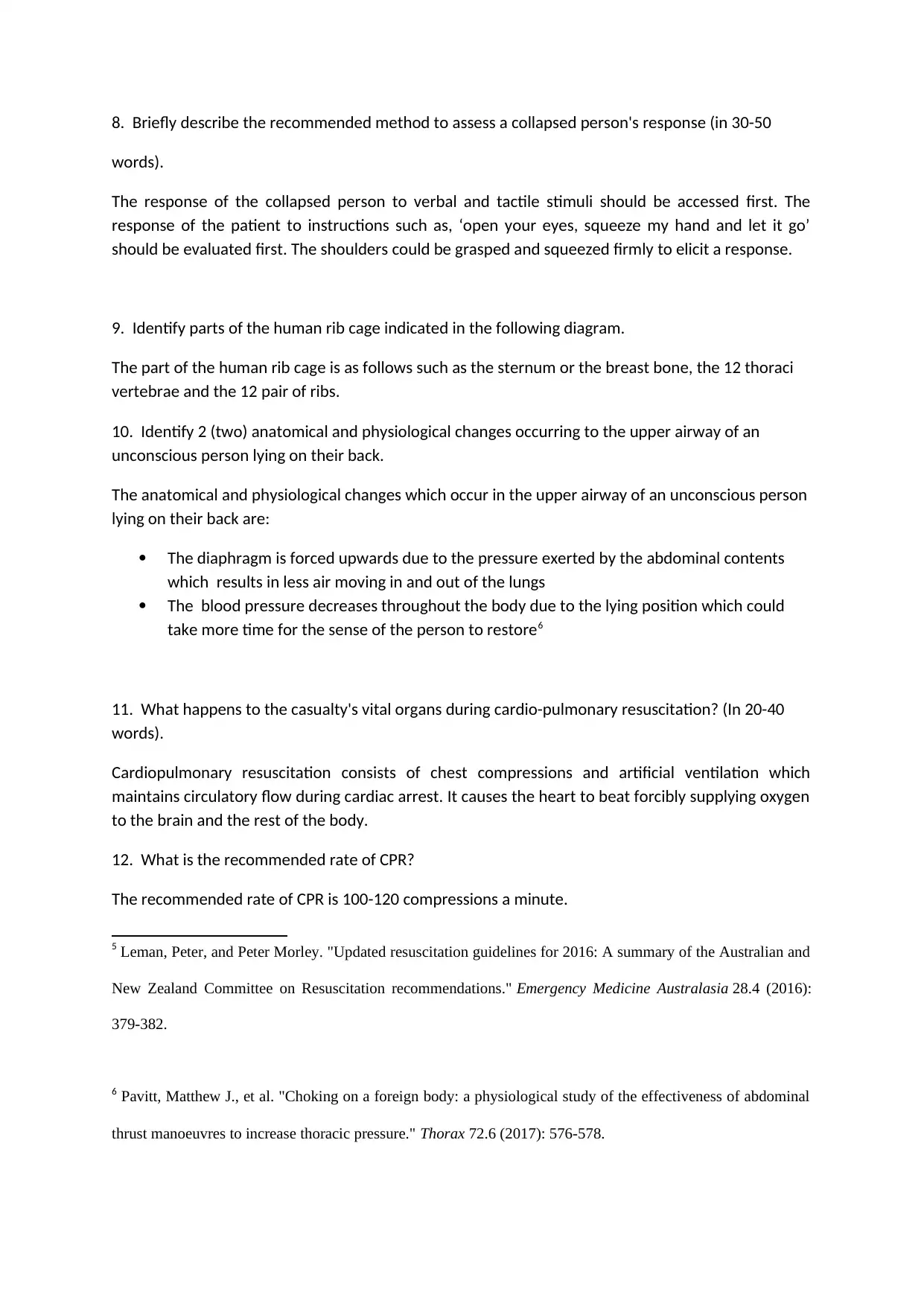
8. Briefly describe the recommended method to assess a collapsed person's response (in 30-50
words).
The response of the collapsed person to verbal and tactile stimuli should be accessed first. The
response of the patient to instructions such as, ‘open your eyes, squeeze my hand and let it go’
should be evaluated first. The shoulders could be grasped and squeezed firmly to elicit a response.
9. Identify parts of the human rib cage indicated in the following diagram.
The part of the human rib cage is as follows such as the sternum or the breast bone, the 12 thoraci
vertebrae and the 12 pair of ribs.
10. Identify 2 (two) anatomical and physiological changes occurring to the upper airway of an
unconscious person lying on their back.
The anatomical and physiological changes which occur in the upper airway of an unconscious person
lying on their back are:
The diaphragm is forced upwards due to the pressure exerted by the abdominal contents
which results in less air moving in and out of the lungs
The blood pressure decreases throughout the body due to the lying position which could
take more time for the sense of the person to restore6
11. What happens to the casualty's vital organs during cardio-pulmonary resuscitation? (In 20-40
words).
Cardiopulmonary resuscitation consists of chest compressions and artificial ventilation which
maintains circulatory flow during cardiac arrest. It causes the heart to beat forcibly supplying oxygen
to the brain and the rest of the body.
12. What is the recommended rate of CPR?
The recommended rate of CPR is 100-120 compressions a minute.
5 Leman, Peter, and Peter Morley. "Updated resuscitation guidelines for 2016: A summary of the Australian and
New Zealand Committee on Resuscitation recommendations." Emergency Medicine Australasia 28.4 (2016):
379-382.
6 Pavitt, Matthew J., et al. "Choking on a foreign body: a physiological study of the effectiveness of abdominal
thrust manoeuvres to increase thoracic pressure." Thorax 72.6 (2017): 576-578.
words).
The response of the collapsed person to verbal and tactile stimuli should be accessed first. The
response of the patient to instructions such as, ‘open your eyes, squeeze my hand and let it go’
should be evaluated first. The shoulders could be grasped and squeezed firmly to elicit a response.
9. Identify parts of the human rib cage indicated in the following diagram.
The part of the human rib cage is as follows such as the sternum or the breast bone, the 12 thoraci
vertebrae and the 12 pair of ribs.
10. Identify 2 (two) anatomical and physiological changes occurring to the upper airway of an
unconscious person lying on their back.
The anatomical and physiological changes which occur in the upper airway of an unconscious person
lying on their back are:
The diaphragm is forced upwards due to the pressure exerted by the abdominal contents
which results in less air moving in and out of the lungs
The blood pressure decreases throughout the body due to the lying position which could
take more time for the sense of the person to restore6
11. What happens to the casualty's vital organs during cardio-pulmonary resuscitation? (In 20-40
words).
Cardiopulmonary resuscitation consists of chest compressions and artificial ventilation which
maintains circulatory flow during cardiac arrest. It causes the heart to beat forcibly supplying oxygen
to the brain and the rest of the body.
12. What is the recommended rate of CPR?
The recommended rate of CPR is 100-120 compressions a minute.
5 Leman, Peter, and Peter Morley. "Updated resuscitation guidelines for 2016: A summary of the Australian and
New Zealand Committee on Resuscitation recommendations." Emergency Medicine Australasia 28.4 (2016):
379-382.
6 Pavitt, Matthew J., et al. "Choking on a foreign body: a physiological study of the effectiveness of abdominal
thrust manoeuvres to increase thoracic pressure." Thorax 72.6 (2017): 576-578.
⊘ This is a preview!⊘
Do you want full access?
Subscribe today to unlock all pages.

Trusted by 1+ million students worldwide
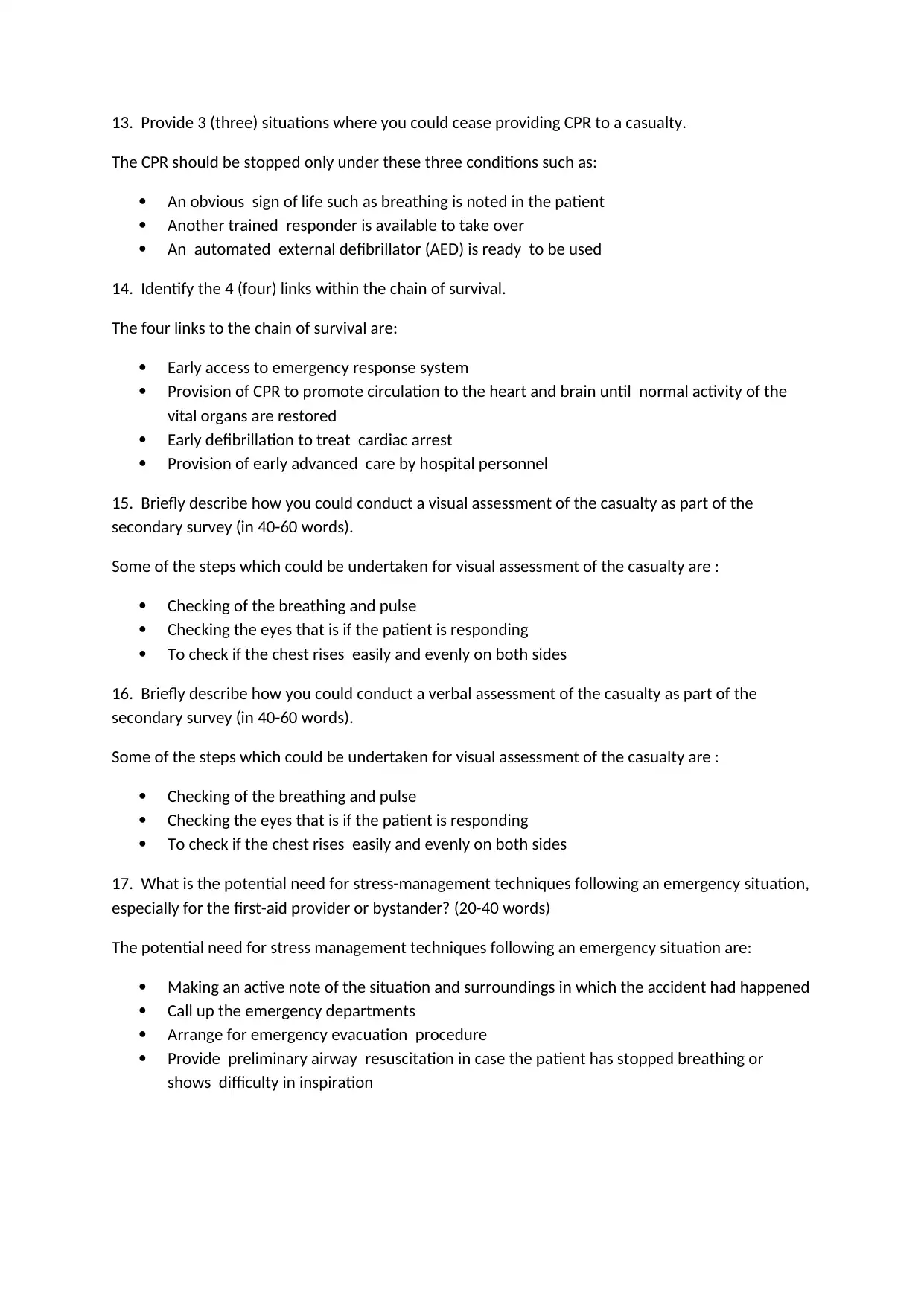
13. Provide 3 (three) situations where you could cease providing CPR to a casualty.
The CPR should be stopped only under these three conditions such as:
An obvious sign of life such as breathing is noted in the patient
Another trained responder is available to take over
An automated external defibrillator (AED) is ready to be used
14. Identify the 4 (four) links within the chain of survival.
The four links to the chain of survival are:
Early access to emergency response system
Provision of CPR to promote circulation to the heart and brain until normal activity of the
vital organs are restored
Early defibrillation to treat cardiac arrest
Provision of early advanced care by hospital personnel
15. Briefly describe how you could conduct a visual assessment of the casualty as part of the
secondary survey (in 40-60 words).
Some of the steps which could be undertaken for visual assessment of the casualty are :
Checking of the breathing and pulse
Checking the eyes that is if the patient is responding
To check if the chest rises easily and evenly on both sides
16. Briefly describe how you could conduct a verbal assessment of the casualty as part of the
secondary survey (in 40-60 words).
Some of the steps which could be undertaken for visual assessment of the casualty are :
Checking of the breathing and pulse
Checking the eyes that is if the patient is responding
To check if the chest rises easily and evenly on both sides
17. What is the potential need for stress-management techniques following an emergency situation,
especially for the first-aid provider or bystander? (20-40 words)
The potential need for stress management techniques following an emergency situation are:
Making an active note of the situation and surroundings in which the accident had happened
Call up the emergency departments
Arrange for emergency evacuation procedure
Provide preliminary airway resuscitation in case the patient has stopped breathing or
shows difficulty in inspiration
The CPR should be stopped only under these three conditions such as:
An obvious sign of life such as breathing is noted in the patient
Another trained responder is available to take over
An automated external defibrillator (AED) is ready to be used
14. Identify the 4 (four) links within the chain of survival.
The four links to the chain of survival are:
Early access to emergency response system
Provision of CPR to promote circulation to the heart and brain until normal activity of the
vital organs are restored
Early defibrillation to treat cardiac arrest
Provision of early advanced care by hospital personnel
15. Briefly describe how you could conduct a visual assessment of the casualty as part of the
secondary survey (in 40-60 words).
Some of the steps which could be undertaken for visual assessment of the casualty are :
Checking of the breathing and pulse
Checking the eyes that is if the patient is responding
To check if the chest rises easily and evenly on both sides
16. Briefly describe how you could conduct a verbal assessment of the casualty as part of the
secondary survey (in 40-60 words).
Some of the steps which could be undertaken for visual assessment of the casualty are :
Checking of the breathing and pulse
Checking the eyes that is if the patient is responding
To check if the chest rises easily and evenly on both sides
17. What is the potential need for stress-management techniques following an emergency situation,
especially for the first-aid provider or bystander? (20-40 words)
The potential need for stress management techniques following an emergency situation are:
Making an active note of the situation and surroundings in which the accident had happened
Call up the emergency departments
Arrange for emergency evacuation procedure
Provide preliminary airway resuscitation in case the patient has stopped breathing or
shows difficulty in inspiration
Paraphrase This Document
Need a fresh take? Get an instant paraphrase of this document with our AI Paraphraser
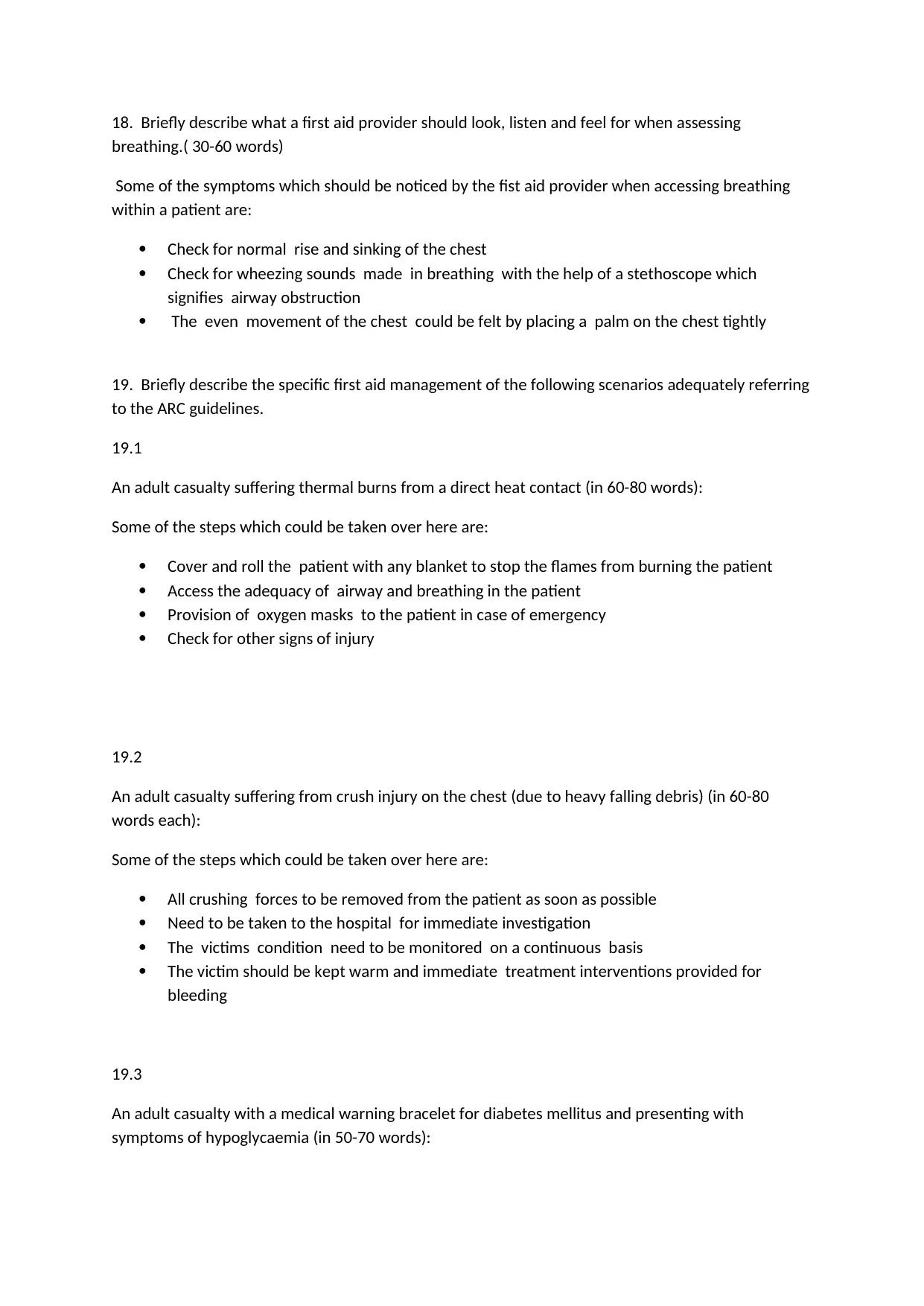
18. Briefly describe what a first aid provider should look, listen and feel for when assessing
breathing.( 30-60 words)
Some of the symptoms which should be noticed by the fist aid provider when accessing breathing
within a patient are:
Check for normal rise and sinking of the chest
Check for wheezing sounds made in breathing with the help of a stethoscope which
signifies airway obstruction
The even movement of the chest could be felt by placing a palm on the chest tightly
19. Briefly describe the specific first aid management of the following scenarios adequately referring
to the ARC guidelines.
19.1
An adult casualty suffering thermal burns from a direct heat contact (in 60-80 words):
Some of the steps which could be taken over here are:
Cover and roll the patient with any blanket to stop the flames from burning the patient
Access the adequacy of airway and breathing in the patient
Provision of oxygen masks to the patient in case of emergency
Check for other signs of injury
19.2
An adult casualty suffering from crush injury on the chest (due to heavy falling debris) (in 60-80
words each):
Some of the steps which could be taken over here are:
All crushing forces to be removed from the patient as soon as possible
Need to be taken to the hospital for immediate investigation
The victims condition need to be monitored on a continuous basis
The victim should be kept warm and immediate treatment interventions provided for
bleeding
19.3
An adult casualty with a medical warning bracelet for diabetes mellitus and presenting with
symptoms of hypoglycaemia (in 50-70 words):
breathing.( 30-60 words)
Some of the symptoms which should be noticed by the fist aid provider when accessing breathing
within a patient are:
Check for normal rise and sinking of the chest
Check for wheezing sounds made in breathing with the help of a stethoscope which
signifies airway obstruction
The even movement of the chest could be felt by placing a palm on the chest tightly
19. Briefly describe the specific first aid management of the following scenarios adequately referring
to the ARC guidelines.
19.1
An adult casualty suffering thermal burns from a direct heat contact (in 60-80 words):
Some of the steps which could be taken over here are:
Cover and roll the patient with any blanket to stop the flames from burning the patient
Access the adequacy of airway and breathing in the patient
Provision of oxygen masks to the patient in case of emergency
Check for other signs of injury
19.2
An adult casualty suffering from crush injury on the chest (due to heavy falling debris) (in 60-80
words each):
Some of the steps which could be taken over here are:
All crushing forces to be removed from the patient as soon as possible
Need to be taken to the hospital for immediate investigation
The victims condition need to be monitored on a continuous basis
The victim should be kept warm and immediate treatment interventions provided for
bleeding
19.3
An adult casualty with a medical warning bracelet for diabetes mellitus and presenting with
symptoms of hypoglycaemia (in 50-70 words):
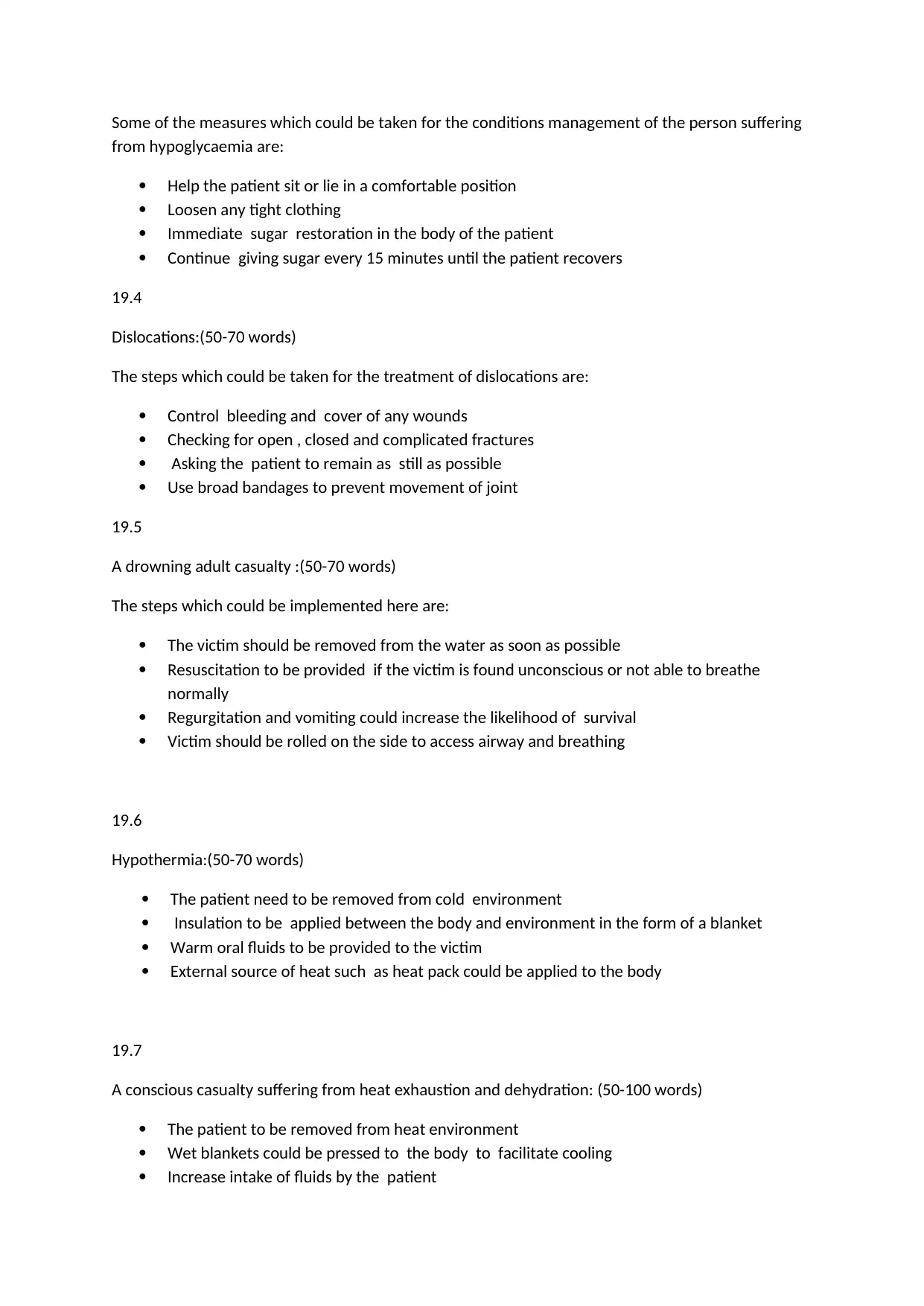
Some of the measures which could be taken for the conditions management of the person suffering
from hypoglycaemia are:
Help the patient sit or lie in a comfortable position
Loosen any tight clothing
Immediate sugar restoration in the body of the patient
Continue giving sugar every 15 minutes until the patient recovers
19.4
Dislocations:(50-70 words)
The steps which could be taken for the treatment of dislocations are:
Control bleeding and cover of any wounds
Checking for open , closed and complicated fractures
Asking the patient to remain as still as possible
Use broad bandages to prevent movement of joint
19.5
A drowning adult casualty :(50-70 words)
The steps which could be implemented here are:
The victim should be removed from the water as soon as possible
Resuscitation to be provided if the victim is found unconscious or not able to breathe
normally
Regurgitation and vomiting could increase the likelihood of survival
Victim should be rolled on the side to access airway and breathing
19.6
Hypothermia:(50-70 words)
The patient need to be removed from cold environment
Insulation to be applied between the body and environment in the form of a blanket
Warm oral fluids to be provided to the victim
External source of heat such as heat pack could be applied to the body
19.7
A conscious casualty suffering from heat exhaustion and dehydration: (50-100 words)
The patient to be removed from heat environment
Wet blankets could be pressed to the body to facilitate cooling
Increase intake of fluids by the patient
from hypoglycaemia are:
Help the patient sit or lie in a comfortable position
Loosen any tight clothing
Immediate sugar restoration in the body of the patient
Continue giving sugar every 15 minutes until the patient recovers
19.4
Dislocations:(50-70 words)
The steps which could be taken for the treatment of dislocations are:
Control bleeding and cover of any wounds
Checking for open , closed and complicated fractures
Asking the patient to remain as still as possible
Use broad bandages to prevent movement of joint
19.5
A drowning adult casualty :(50-70 words)
The steps which could be implemented here are:
The victim should be removed from the water as soon as possible
Resuscitation to be provided if the victim is found unconscious or not able to breathe
normally
Regurgitation and vomiting could increase the likelihood of survival
Victim should be rolled on the side to access airway and breathing
19.6
Hypothermia:(50-70 words)
The patient need to be removed from cold environment
Insulation to be applied between the body and environment in the form of a blanket
Warm oral fluids to be provided to the victim
External source of heat such as heat pack could be applied to the body
19.7
A conscious casualty suffering from heat exhaustion and dehydration: (50-100 words)
The patient to be removed from heat environment
Wet blankets could be pressed to the body to facilitate cooling
Increase intake of fluids by the patient
⊘ This is a preview!⊘
Do you want full access?
Subscribe today to unlock all pages.

Trusted by 1+ million students worldwide
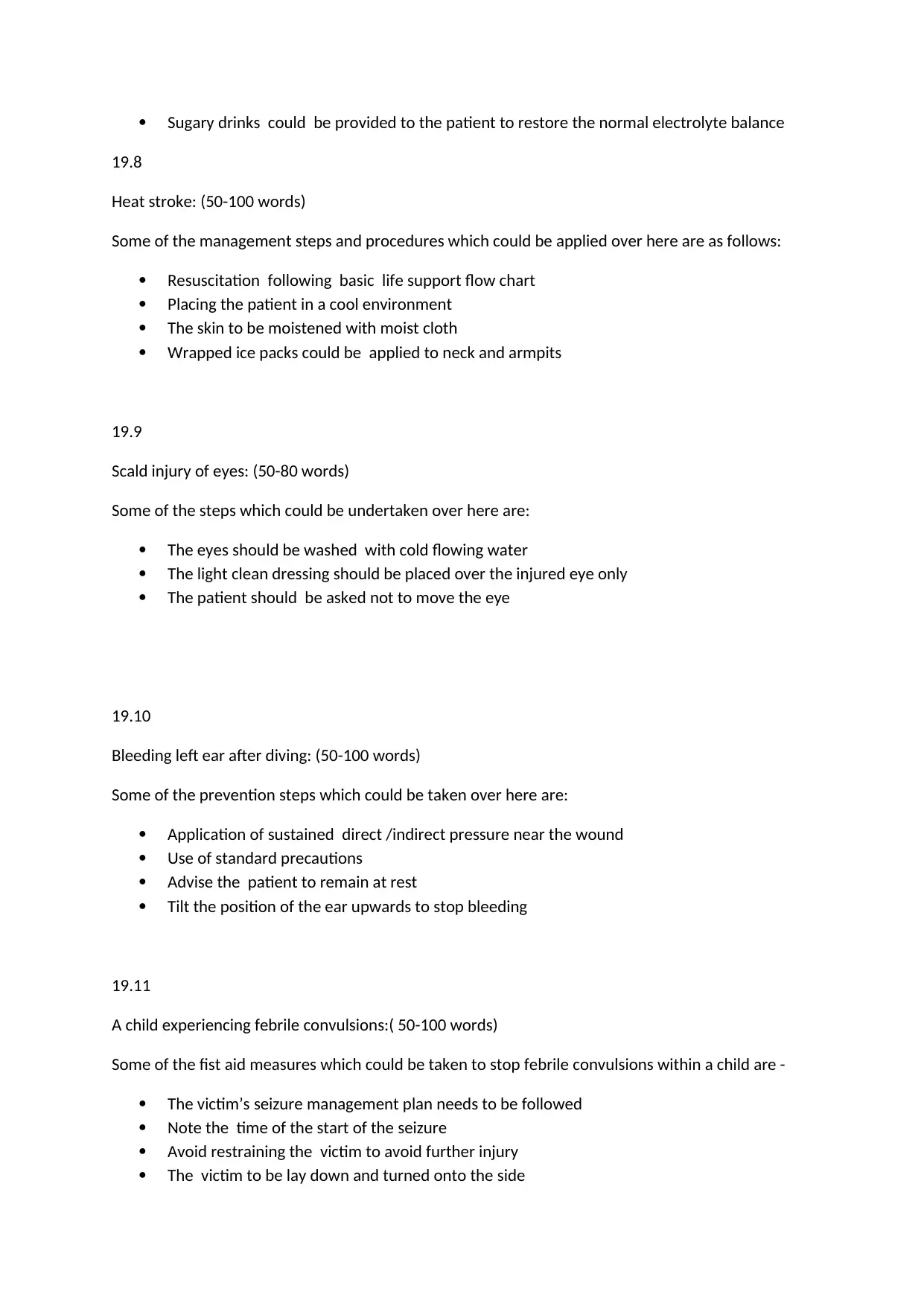
Sugary drinks could be provided to the patient to restore the normal electrolyte balance
19.8
Heat stroke: (50-100 words)
Some of the management steps and procedures which could be applied over here are as follows:
Resuscitation following basic life support flow chart
Placing the patient in a cool environment
The skin to be moistened with moist cloth
Wrapped ice packs could be applied to neck and armpits
19.9
Scald injury of eyes: (50-80 words)
Some of the steps which could be undertaken over here are:
The eyes should be washed with cold flowing water
The light clean dressing should be placed over the injured eye only
The patient should be asked not to move the eye
19.10
Bleeding left ear after diving: (50-100 words)
Some of the prevention steps which could be taken over here are:
Application of sustained direct /indirect pressure near the wound
Use of standard precautions
Advise the patient to remain at rest
Tilt the position of the ear upwards to stop bleeding
19.11
A child experiencing febrile convulsions:( 50-100 words)
Some of the fist aid measures which could be taken to stop febrile convulsions within a child are -
The victim’s seizure management plan needs to be followed
Note the time of the start of the seizure
Avoid restraining the victim to avoid further injury
The victim to be lay down and turned onto the side
19.8
Heat stroke: (50-100 words)
Some of the management steps and procedures which could be applied over here are as follows:
Resuscitation following basic life support flow chart
Placing the patient in a cool environment
The skin to be moistened with moist cloth
Wrapped ice packs could be applied to neck and armpits
19.9
Scald injury of eyes: (50-80 words)
Some of the steps which could be undertaken over here are:
The eyes should be washed with cold flowing water
The light clean dressing should be placed over the injured eye only
The patient should be asked not to move the eye
19.10
Bleeding left ear after diving: (50-100 words)
Some of the prevention steps which could be taken over here are:
Application of sustained direct /indirect pressure near the wound
Use of standard precautions
Advise the patient to remain at rest
Tilt the position of the ear upwards to stop bleeding
19.11
A child experiencing febrile convulsions:( 50-100 words)
Some of the fist aid measures which could be taken to stop febrile convulsions within a child are -
The victim’s seizure management plan needs to be followed
Note the time of the start of the seizure
Avoid restraining the victim to avoid further injury
The victim to be lay down and turned onto the side
Paraphrase This Document
Need a fresh take? Get an instant paraphrase of this document with our AI Paraphraser

19.12
Management of epilepsy (the first seizure episode lasted for five or more minutes and a second
seizure quickly followed the first): (50-100 words)
Some of the steps which could be taken for management of epilepsy within a child are -
Follow up with the seizure management plan
The time of start of seizure to be noted
The patient to be transferred to an open and spacious environment
The victim to be started on with airway resuscitation
19.13
A casualty in shock following severe bleeding: (50-100 words)
Some of the steps which could be taken over here are:
The victim to be placed in supine position
The bleeding in the patient to be controlled promptly
Oxygen treatment to be provided to the patient
Body temperature of the patient to be maintained
19.14
Casualties suffering from sprain bruise and strain (50-80 words)
Some of the measures which could be taken for prevention of sprain, bruise and strain in an
individual are -
Icepack to be applied at the site of sprain and bruise
The injured part need to be elevated
Compression elastic bandage could be firmly applied to the wound
19.15
A casualty presenting with sudden (acute) facial weakness, arm weakness, difficulty in speaking: (50-
100 words)
Some of the factors which could be taken for the treatment of facial weakness, arm weakness and
speaking difficulty are-
Management of epilepsy (the first seizure episode lasted for five or more minutes and a second
seizure quickly followed the first): (50-100 words)
Some of the steps which could be taken for management of epilepsy within a child are -
Follow up with the seizure management plan
The time of start of seizure to be noted
The patient to be transferred to an open and spacious environment
The victim to be started on with airway resuscitation
19.13
A casualty in shock following severe bleeding: (50-100 words)
Some of the steps which could be taken over here are:
The victim to be placed in supine position
The bleeding in the patient to be controlled promptly
Oxygen treatment to be provided to the patient
Body temperature of the patient to be maintained
19.14
Casualties suffering from sprain bruise and strain (50-80 words)
Some of the measures which could be taken for prevention of sprain, bruise and strain in an
individual are -
Icepack to be applied at the site of sprain and bruise
The injured part need to be elevated
Compression elastic bandage could be firmly applied to the wound
19.15
A casualty presenting with sudden (acute) facial weakness, arm weakness, difficulty in speaking: (50-
100 words)
Some of the factors which could be taken for the treatment of facial weakness, arm weakness and
speaking difficulty are-
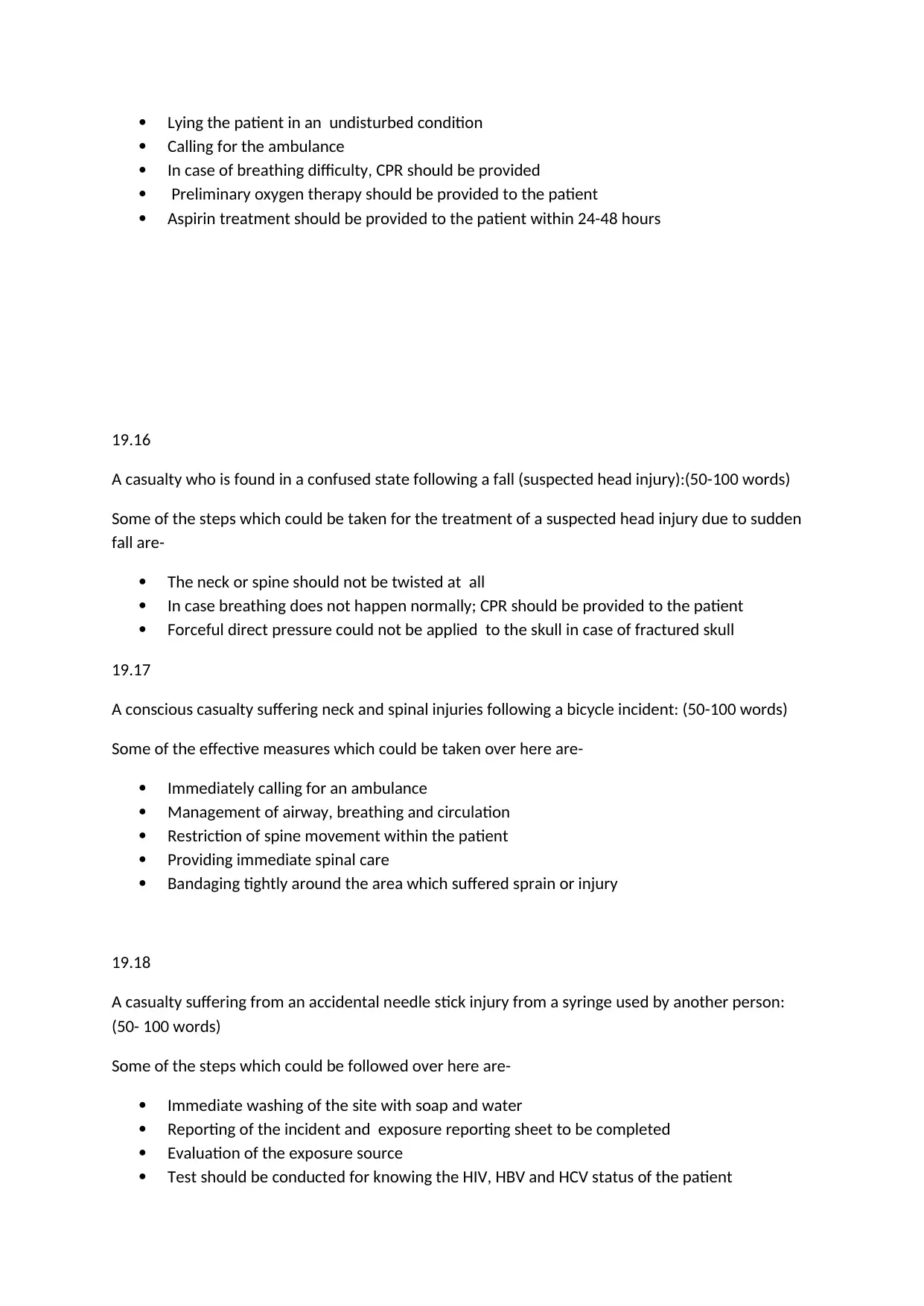
Lying the patient in an undisturbed condition
Calling for the ambulance
In case of breathing difficulty, CPR should be provided
Preliminary oxygen therapy should be provided to the patient
Aspirin treatment should be provided to the patient within 24-48 hours
19.16
A casualty who is found in a confused state following a fall (suspected head injury):(50-100 words)
Some of the steps which could be taken for the treatment of a suspected head injury due to sudden
fall are-
The neck or spine should not be twisted at all
In case breathing does not happen normally; CPR should be provided to the patient
Forceful direct pressure could not be applied to the skull in case of fractured skull
19.17
A conscious casualty suffering neck and spinal injuries following a bicycle incident: (50-100 words)
Some of the effective measures which could be taken over here are-
Immediately calling for an ambulance
Management of airway, breathing and circulation
Restriction of spine movement within the patient
Providing immediate spinal care
Bandaging tightly around the area which suffered sprain or injury
19.18
A casualty suffering from an accidental needle stick injury from a syringe used by another person:
(50- 100 words)
Some of the steps which could be followed over here are-
Immediate washing of the site with soap and water
Reporting of the incident and exposure reporting sheet to be completed
Evaluation of the exposure source
Test should be conducted for knowing the HIV, HBV and HCV status of the patient
Calling for the ambulance
In case of breathing difficulty, CPR should be provided
Preliminary oxygen therapy should be provided to the patient
Aspirin treatment should be provided to the patient within 24-48 hours
19.16
A casualty who is found in a confused state following a fall (suspected head injury):(50-100 words)
Some of the steps which could be taken for the treatment of a suspected head injury due to sudden
fall are-
The neck or spine should not be twisted at all
In case breathing does not happen normally; CPR should be provided to the patient
Forceful direct pressure could not be applied to the skull in case of fractured skull
19.17
A conscious casualty suffering neck and spinal injuries following a bicycle incident: (50-100 words)
Some of the effective measures which could be taken over here are-
Immediately calling for an ambulance
Management of airway, breathing and circulation
Restriction of spine movement within the patient
Providing immediate spinal care
Bandaging tightly around the area which suffered sprain or injury
19.18
A casualty suffering from an accidental needle stick injury from a syringe used by another person:
(50- 100 words)
Some of the steps which could be followed over here are-
Immediate washing of the site with soap and water
Reporting of the incident and exposure reporting sheet to be completed
Evaluation of the exposure source
Test should be conducted for knowing the HIV, HBV and HCV status of the patient
⊘ This is a preview!⊘
Do you want full access?
Subscribe today to unlock all pages.

Trusted by 1+ million students worldwide

19.19
A conscious casualty who mistakenly ingested a poisonous substance: (50-80 words)
Some of the steps which could be followed over here are:
Prevention of poisoning of the rescuer
Decontamination of the patient
Resuscitation and care as per Basic life support flowchart
Specific management of particular poisons
CPR to be provided in Case the patient is not breathing properly
19.20
A conscious casualty who has inhaled a toxic substance (50-80 words):
Some of the steps which could be taken with the patient are-
Immediately getting the person to fresh air
Breathing fumes should be avoided
The doors and windows should be opened to prevent choking in the patient
In case of abnormal breathing CPR could be provided
Artificial oxygen to be started on the patient in case of choking
20. Identify the piece of good Samaritan™ legislation relevant to your State/Territory. Briefly outline
the application of the identified Act in the provision of first aid (in 30-50 words).
A Good Samaritan is an individual who comes to the help or assistance of a person who has suffered
injury without keeping any expectation from anyone7. A number of guidelines have been stated for
application of the act in relation to fist aid such as –
To act in good faith
Not to expect reward or payment for the act
To assist the injure person
The acts doesnot necessarily apply to the health professionals only
7 McLanders, M. L., et al. "The cognitive aids in medicine assessment tool (CMAT) applied to five neonatal
resuscitation algorithms." Journal of Perinatology 37.4 (2017): 387.
A conscious casualty who mistakenly ingested a poisonous substance: (50-80 words)
Some of the steps which could be followed over here are:
Prevention of poisoning of the rescuer
Decontamination of the patient
Resuscitation and care as per Basic life support flowchart
Specific management of particular poisons
CPR to be provided in Case the patient is not breathing properly
19.20
A conscious casualty who has inhaled a toxic substance (50-80 words):
Some of the steps which could be taken with the patient are-
Immediately getting the person to fresh air
Breathing fumes should be avoided
The doors and windows should be opened to prevent choking in the patient
In case of abnormal breathing CPR could be provided
Artificial oxygen to be started on the patient in case of choking
20. Identify the piece of good Samaritan™ legislation relevant to your State/Territory. Briefly outline
the application of the identified Act in the provision of first aid (in 30-50 words).
A Good Samaritan is an individual who comes to the help or assistance of a person who has suffered
injury without keeping any expectation from anyone7. A number of guidelines have been stated for
application of the act in relation to fist aid such as –
To act in good faith
Not to expect reward or payment for the act
To assist the injure person
The acts doesnot necessarily apply to the health professionals only
7 McLanders, M. L., et al. "The cognitive aids in medicine assessment tool (CMAT) applied to five neonatal
resuscitation algorithms." Journal of Perinatology 37.4 (2017): 387.
Paraphrase This Document
Need a fresh take? Get an instant paraphrase of this document with our AI Paraphraser

21. Is gasping™ a normal respiratory pattern? How could you describe gasping? (In 20-40 words).
Gasping or agonal breath is an abnormal breathing pattern. It is the body’s attempt to breathe after
the heart has stopped. Sometimes it could be associated with the early stages of cardiac arrest.
22. What happens to a casualty™s upper airway with the head tilt/chin lift manoeuvre? (In 20-30
words).
It is particularly applied in patients who face difficulty in breathing where an upward tilt can help
them in taking the maximum oxygen which could help them in coping with the oxygen distress.
Gasping or agonal breath is an abnormal breathing pattern. It is the body’s attempt to breathe after
the heart has stopped. Sometimes it could be associated with the early stages of cardiac arrest.
22. What happens to a casualty™s upper airway with the head tilt/chin lift manoeuvre? (In 20-30
words).
It is particularly applied in patients who face difficulty in breathing where an upward tilt can help
them in taking the maximum oxygen which could help them in coping with the oxygen distress.

References
Cartledge, Susie, et al. "Incorporating cardiopulmonary resuscitation training into a cardiac
rehabilitation programme: A feasibility study." European Journal of Cardiovascular
Nursing 17.2 (2018): 148-158.
Grantham, Hugh, and Rowena Christiansen. "Resuscitation update for general
practitioners." Australian family physician45.12 (2016): 879.
Leman, Peter, and Peter Morley. "Updated resuscitation guidelines for 2016: A summary of
the Australian and New Zealand Committee on Resuscitation recommendations." Emergency
Medicine Australasia 28.4 (2016): 379-382.
McKenzie, Lachlan, et al. "Twenty-one years of saving lives: The New Zealand Resuscitation
Council." The New Zealand Medical Journal (Online) 131.1477 (2018): 9-11.
McLanders, M. L., et al. "The cognitive aids in medicine assessment tool (CMAT) applied to
five neonatal resuscitation algorithms." Journal of Perinatology 37.4 (2017): 387.
Pavitt, Matthew J., et al. "Choking on a foreign body: a physiological study of the
effectiveness of abdominal thrust manoeuvres to increase thoracic pressure." Thorax 72.6
(2017): 576-578.
Cartledge, Susie, et al. "Incorporating cardiopulmonary resuscitation training into a cardiac
rehabilitation programme: A feasibility study." European Journal of Cardiovascular
Nursing 17.2 (2018): 148-158.
Grantham, Hugh, and Rowena Christiansen. "Resuscitation update for general
practitioners." Australian family physician45.12 (2016): 879.
Leman, Peter, and Peter Morley. "Updated resuscitation guidelines for 2016: A summary of
the Australian and New Zealand Committee on Resuscitation recommendations." Emergency
Medicine Australasia 28.4 (2016): 379-382.
McKenzie, Lachlan, et al. "Twenty-one years of saving lives: The New Zealand Resuscitation
Council." The New Zealand Medical Journal (Online) 131.1477 (2018): 9-11.
McLanders, M. L., et al. "The cognitive aids in medicine assessment tool (CMAT) applied to
five neonatal resuscitation algorithms." Journal of Perinatology 37.4 (2017): 387.
Pavitt, Matthew J., et al. "Choking on a foreign body: a physiological study of the
effectiveness of abdominal thrust manoeuvres to increase thoracic pressure." Thorax 72.6
(2017): 576-578.
⊘ This is a preview!⊘
Do you want full access?
Subscribe today to unlock all pages.

Trusted by 1+ million students worldwide
1 out of 12
Related Documents
Your All-in-One AI-Powered Toolkit for Academic Success.
+13062052269
info@desklib.com
Available 24*7 on WhatsApp / Email
![[object Object]](/_next/static/media/star-bottom.7253800d.svg)
Unlock your academic potential
Copyright © 2020–2025 A2Z Services. All Rights Reserved. Developed and managed by ZUCOL.





